The 1950s era of “Mom, baseball and apple pie!” was fading as the 1960s took hold. It was a more pivotal time in American history, but baseball was still the top sport in America and boys were still buying baseball cards as fast as they could be printed. This was also a time of hand-me-down collections that met larger and larger Topps sets as more Major League Baseball teams were coming to fruition. Some of the greatest players in history come into the game int the 1960s and many of their baseball records are still unrivaled..
Collectors Dashboard wanted to look at the top 10 rookie baseball cards of the 1960s.
One issue which prevailed during the 1960s is that Topps dominated sports cards. There just really were no significant rivals that made a dent during the decade, even with a few sets being issued by Fleer and some cards on cereal boxes.
One major change that occurred in baseball cards of the 1960s versus prior decades was that rookies were frequently featured with at least one other player as “rookie stars” by Topps. Baseball card sets also expanded from the 250 to 400 cards of the 1950s up to above 600 cards by the end of the decade.
Collectors Dashboard evaluates collectibles as an alternative asset class. The same capital that could have been invested into stocks or bonds is being used to buy high-end collectibles. And cards that cost in the thousands or tens of thousands certainly rival stock and bond purchases. And in this hunt, die-hard collectors are also in a constant battle with investors who want to own the same exact asset.
Collectors Dashboard has compiled the top 10 rookie cards of the 1960s. These players welcomed a new era of collecting. The dynamics of baseball were becoming fully integrated at the same time that baseball cards became more mass produced. Many of the 1960s rookie cards have the same production errors or difficulties of the prior decade. The one constant, outside of some sub-set variations in some years, was that that the card size of the late 1950s remained constant and that has remained constant to this day.
There is an honorable mention as well. One issue that stands out is that the top rookie cards were not always players who won AL/NL Rookie of the Year. And other “top 10” lists may vary based on other data, and admittedly based upon opinion.
Generally speaking, these are the most valuable cards of the 1960s. We have skipped over whether or not there are rarities such as O-Pee-Chee cards and the even more rare Venezuelan issued cards. These cards are also featured in the order of issuance rather than featured by value or other statistics.
Here is the top 10 rookie baseball cards of the 1960s in the eyes of Collectors Dashboard. As you will notice, most of the top rookie cards are multi-player cards. Please note that the population reports were as of August 2021 and are being refreshed as SGC, PSA and others update those reports since the floodgate of card submissions hit in 2020 and early 2021.
1. Carl Yastrzemski – 1960 Topps #148
A collectors favorite for decades, the Yastrzemski card is colorful and features how expensive it was for the Red Sox to sign Yaz as a rookie. While the card has a high population, the Yaz rookie was plagued with production issues like printing lines and centering that make higher grades more difficult.
It is also possible to consider that the modern era Yaz has helped to keep Carl (Yaz) more relevant to some collectors. Some will consider the Yastrzemski rookie more art than photography as well. The total population is quite high with about 8,319 PSA examples. SGC’s total population is 1,472. (Image from Jon Ogg)
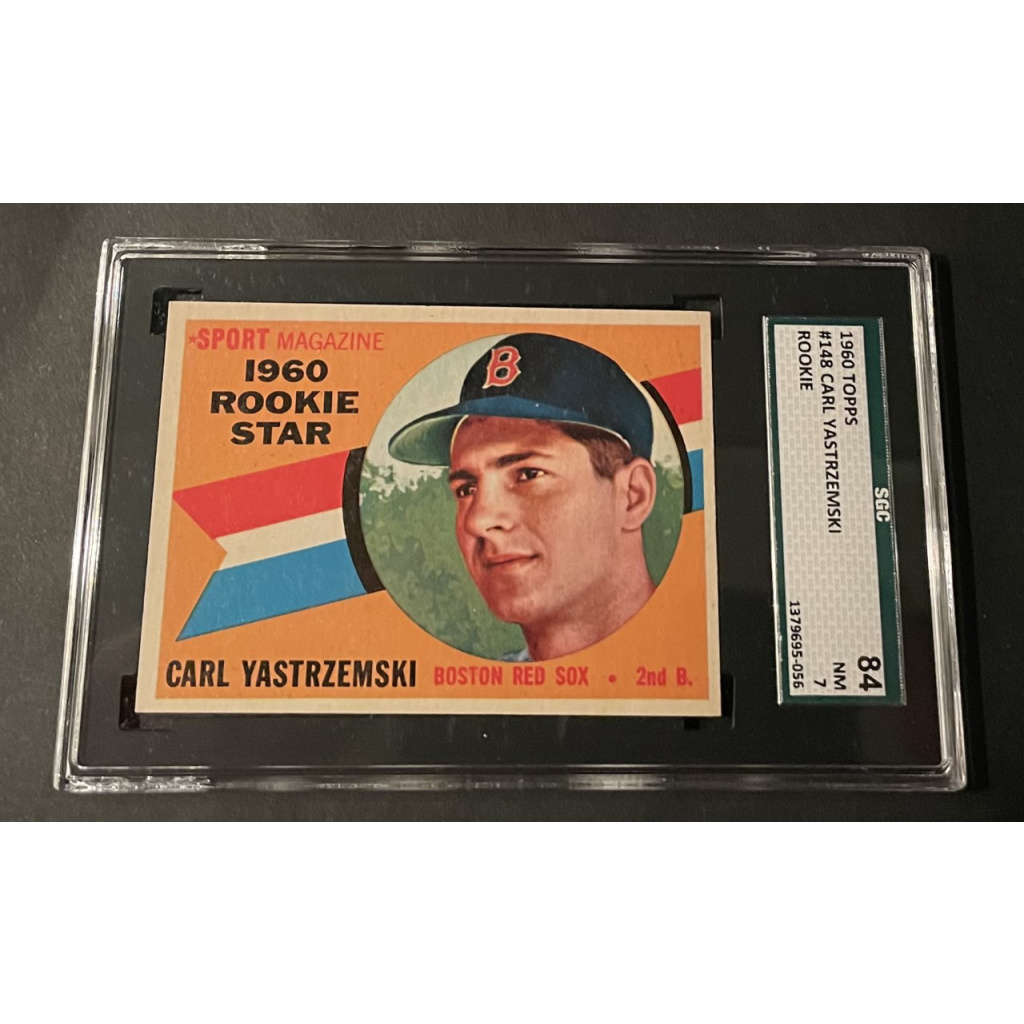
2. Willie McCovey* – 1960 Topps (#316 and #554)
1960 Topps #316 Willie McCovey is plagued by printing defects and for poor centering. A high graded and perfectly centered example is very desirable. According to the PSA Card Facts, Topps blended the use of color photography with artwork throughout the 1960 set. It was not the norm to have a rookie featured twice within a card set in this period. The All Star card #554 listed below is important, and PSA even notes that it has never been equal to #316. The total population is quite high with about 4,627 PSA examples. SGC’s total population is 769.
Willie McCovey All-Star #554 was very uncommon for the 1960s two have two rookie cards for the same player. Willie McCovey hit 521 career home runs. The All-Star cards are generally less desired than base cards of major players throughout vintage cards, but this is a high-number series and has a much lower population than the base card. Despite a lower supply of cards, the base rookie is still more valuable for collectors. McCovey also won the NL Rookie of the Year in 1959. The total population is 1,221 PSA examples and SGC’s total population is 149 cards. (Willie McCovey image provided by Heritage Auctions)

3. Lou Brock – 1962 Topps #387
The 1962 Topps Lou Brock rookie card is the most important rookie of the entire set. It can be difficult to find in high-grades because the edges have the brown wood grain appearance that makes any dings, chipping or rubber band marks stand out. The centering is also an issue. Brock ended his career with 3,023 hits and a whopping 938 stolen bases. The total PSA population for the Lou Brock rookie card is 3,461 examples versus 562 from SGC. (Lou Brock rookie image provided by Heritage Auctions)
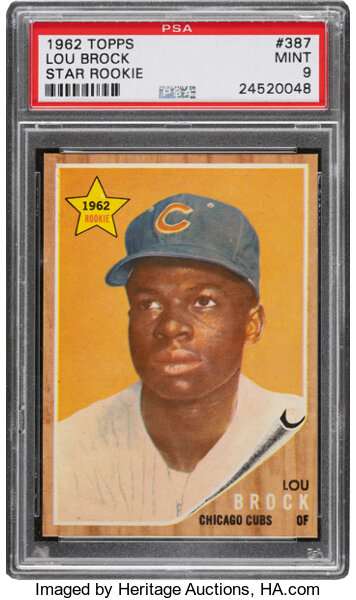
4. Pete Rose – 1963 Topps #537
The Pete Rose rookie card comes with three other rookies for the same year: Pedro Gonzales for the Yankees, Ken McMullen for the Dodgers, and Al Weis. While collectors chase this card’s prices higher in the top grades, Roses’s face is quite small on this rookie many collectors prefer the 1964 Topps Pete Rose card despite the value being highest in 1963. Rose would have been a shoe-in to the Hall of Fame had it not been for his major gambling scandal. Rose was the NL Rookie of the Year in 1963. He ended with a baseball high of 4,256 hits. Rose ended with a .303 batting average, but he only had one season under .300 from 1965 through 1979. The total graded population is 5,257 from PSA and SGC’s total population is 1,107. (Pete Rose rookie PSA 10 image provided by Heritage Auctions)
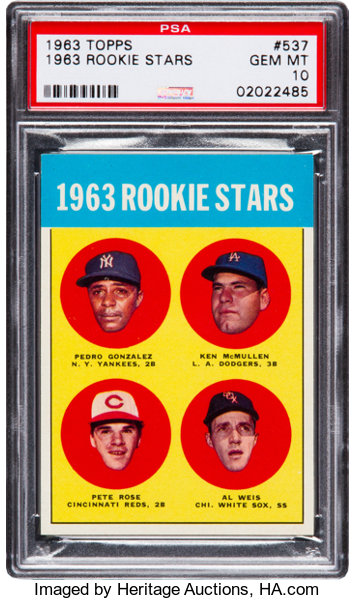
5. Steve Carlton – 1965 Topps #477
Steve Carlton’s card shares the space with fellow pitcher and teammate Fritz Ackley. The Carlton Rookie card is not all that scarce in the higher grades and the white borders of the set are well defined. Still, the dark background on the front of the card and chipping on the back are known issues for the set. Carlton ended his career with 329 wins and 244 losses, and in the 24-year span he ended with a 3.22 ERA and racked up 4,136 strike outs. The total graded population is 6,112 PSA examples and SGC’s total population is 1,022. (Steve Carlton rookie image provided by Heritage Auctions)

6. Rod Carew – 1967 Topps #569
The 1967s Topps set is considered one of the more attractive sets from the entire 1960s. Rod Carew shares the front with Hank Allen of the Washington Senators. The card frequently has poor centering, and the green border on the back of 1967 Topps cards that can reveal the slightest hint of wear. Carew ended his career with an impressive .328 batting average and 3,053 career hits. He was also Rookie of the Year for his card’s debut. The total population is 3,134 PSA examples. SGC’s total population is 691. (Rod Carew PSA 10 rookie image from Heritage Auctions)

7. Tom Seaver – 1967 Topps #581
The card for Tom Seaver is shared with Bill Denehy. The Seaver rookie is frequently represented as the most valuable card in the entire 1967 Topps set. That may not be true every single auction, but generally it is true. It can also be challenging to find this card well centered. Like other 1967 cards the reverse has a green colored border that will reveal wear along the edges. Seaver’s career spanned 20 years, ending with 311 wins versus 205 losses and with a 2.86 ERA. Seaver also struck out 3,640 batters and he won Rookie of the Year for his debut card. The total graded population is 3,396 from PSA and 660 from SGC. (Tom Seaver rookie image provided by Heritage Auctions)

8. Nolan Ryan – 1968 Topps #177
Nolan Ryan is the most well-know pitcher of all-time, but his cards were not an immediate hit. The Nolan Ryan rookie is shared with Mets teammate Jerry Koosman, and some collectors chase the other versions of the Ryan rookie card. Where the Nolan Ryan rookie stands out is that the card is much harder to find in the highest grades. The plaid border shows any defects, the paper often has the look of being soft visually, and centering can be an issue. Despite all of this, the total graded population is quite high. Nolan Ryan pitched for 27 seasons, and his 5,714 strike outs and 7 no-hitters may never be rivaled in an era where pitchers now are shifted in and out like pawns in chess. Ryan ended with 324 wins and 292 losses, and despite many walks his 100-mph fast balls terrorized batters. There are 12,806 graded by PSA and SGC’s total graded population is 2,499. Despite such a large population of cards, he PSA registry counts only 1 perfect PSA 10 and just 66 PSA 9 base grades without qualifiers. (Ryan rookie image from Heritage Auctions)
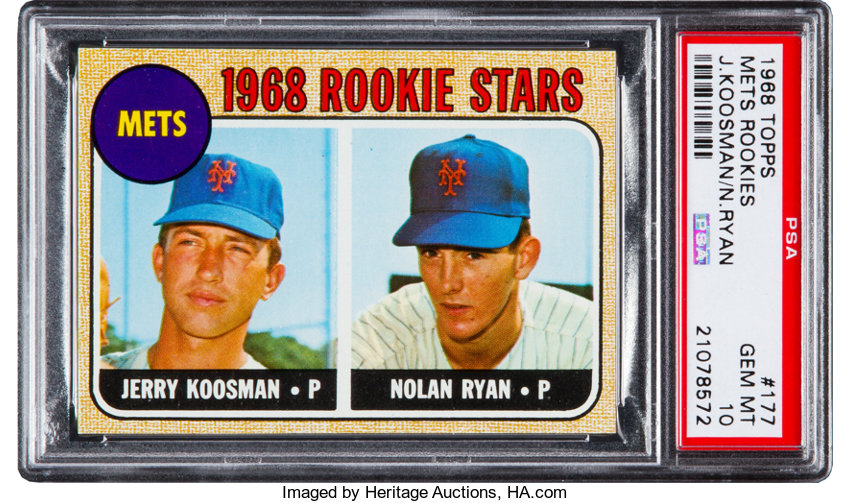
9. Johnny Bench – 1968 Topps #247
The Johnny Bench rookie also shares the card Ron Tompkins. Centering is frequently an issue, as are any blemishes standing out from the plaid edges. The solid color on the back also makes chipping an issue that hurts the grade. Johnny Bench is baby-faced and wearing a backwards ball cap that had been featured so prominently in prior decades. The Bench rookie would be a leader in almost any year, except that Nolan Ryan was in the same set. Bench is considered to be the greatest catcher of all-time for many baseball fans. Bench won Rookie of the Year for his debut and he was on every All-Star team from 1968 to 1980. The total graded population is 9,126 PSA examples. SGC’s total population is 1,588. (Johnny Bench PSA 10 rookie image from Heritage Auctions)
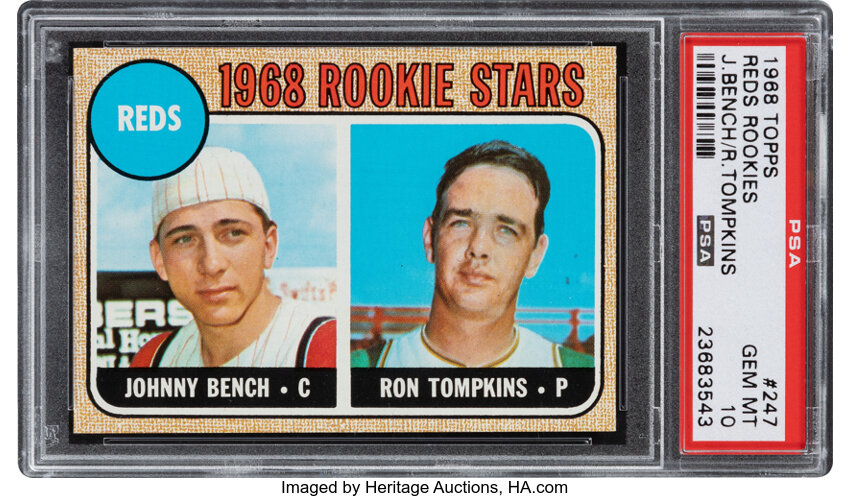
10. Reggie Jackson – 1969 Topps #260
The Reggie Jackson 1969 Topps Rookie card breaks the common mold for 1960s rookie cards because he does not share the card with another player. The card is also considered to have great eye appeal with a light blue sky and a soft background. According to PSA, Reggie Jackson’s rookie card is harder to find in top grades. The solid pink/salmon color on the back makes any wear or dings stand out. Another issue which can be noted is an image tilt that can lower the card’s eye appeal. Some of Jackson’s rookie cards also look faded while others have a sharper colors. On top of being a fan-favorite and having his own candy bar to magnify his fame, Reggie Jackson’s 21-year career included 2,584 hits and 563 home runs. The total population is 8,152 PSA examples. SGC’s total population is 1,569. (Reggie Jackson PSA 10 image provided by Heritage Auctions)
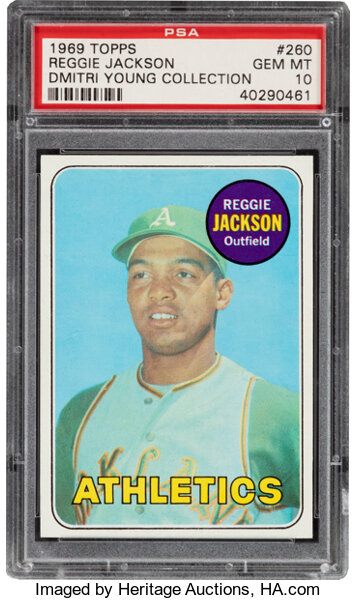
*******************
Collectors and investors covet each new hot rookie player. That said, Collectors Dashboard has demonstrated why chasing Rookie of the Year can be quite painful.
An honorable mention goes out to Willie Stargell’s 1963 Topps #553 rookie. Willie Stargell is a Hall of Fame inductee of the class of 1988. He is featured with three other rookies and the solid blue border along the top makes defects stand out. Centering can also be difficult and bright colored background allows print defects to stand out. The total graded population is 2,544 from PSA and 493 from SGC.


